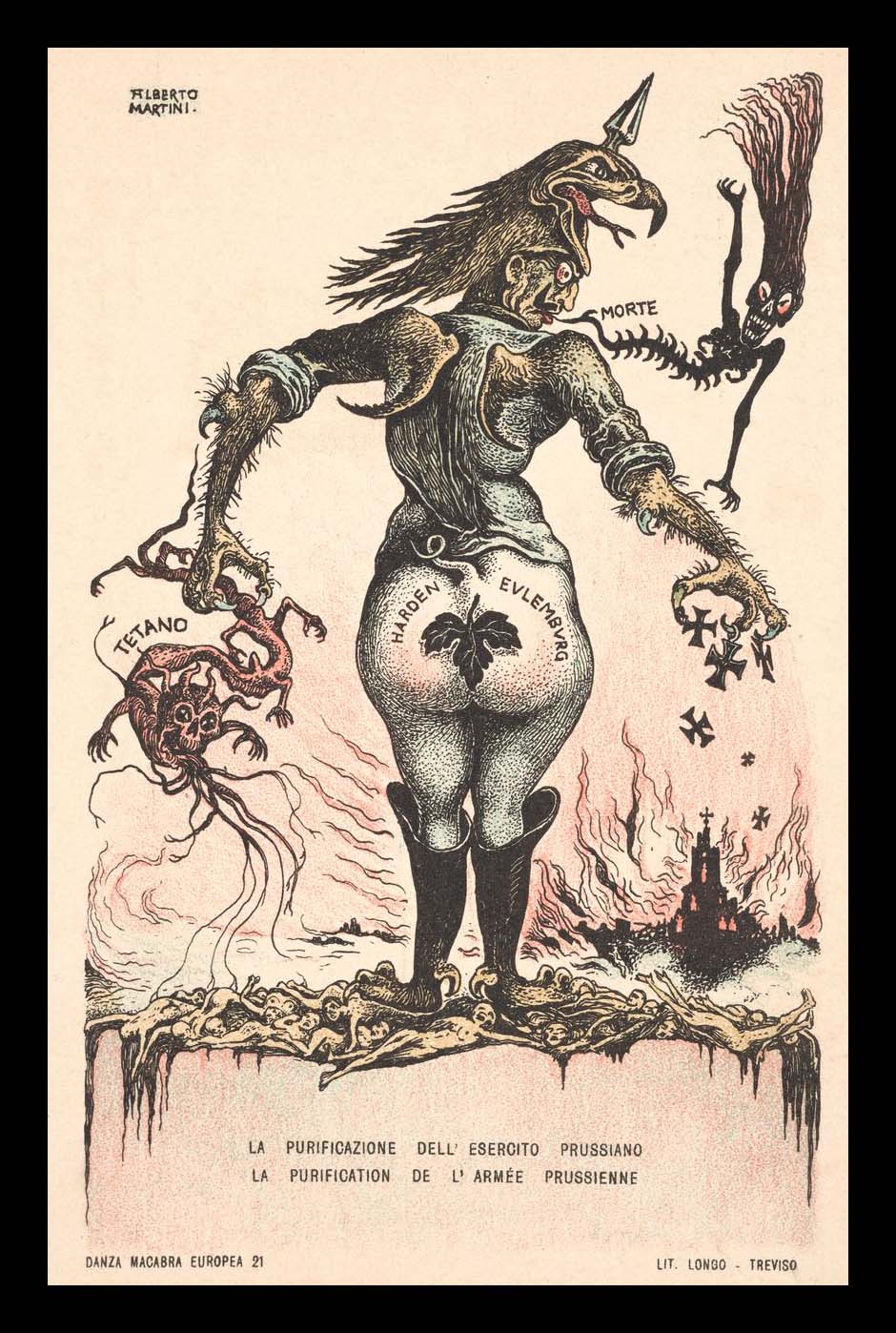Bestiary: Dante to World War I

An illustration from an early-modern (1579) “animal book” from Switzerland and one from an edition of Dante’s Divine Comedy published 170 years after the author’s death (1491) provide context for twentieth-century specimens of the bestiary genre. Dante represents a link between late-Medieval European culture, with its renewed interest in the literature and iconographies of Greco-Roman antiquity, and modernity. In the Divine Comedy, a work of immense influence on modern culture from its composition through to the present day, Dante re-elaborated the iconographies of Roman poets Virgil and Ovid, among others, and fused them with Judeo-Christian iconography to create human-animal hybrid figures representing different varieties of moral excellence and degradation.
These two early-modern works are displayed here alongside early twentieth-century works of visual satire where the targets are depicted as human-beast monstrosities, including some that are explicit re-elaborations of figures from the Divine Comedy.
The Master of the Pico Pliny (15th century)
La Commedia, 1491
Italy (Venice), Italian
William H. Scheide Collection
This woodcut illustrates an encounter from the first canto of Inferno (and of the poem as a whole). This is the moment in the poem’s allegorical introduction when Dante’s autobiographical protagonist is blocked on the path of redemption by three terrifying beasts representing vices he has not yet conquered in himself: a leopard representing lust, a lion representing pride, and a wolf representing greed.
Bestiaries Tierbuch, 1579
Jost Amman, 1539-1591
Switzerland, German
Four woodcut illustrations from a 1579 Tierbuch or “animal book” produced in Switzerland. In the verse text below the images the animals are identified as embodiments of specific qualities: the lion — fierceness; the goat — patient forbearance, etc. This sixteenth-century document illustrates the perception that different animal species are embodiments — and by extension, symbols — of qualities of character also found in humans.
La Kolossal Infernal Tragedia: Pro Kultur (The Colossal Infernal Tragedy: Pro Kultur), 1915
Guido Baldassare (dates unknown)
Italy, Italian
This set of 12 illustrated black and white photo-print postcards features images by the Italian illustrator Guido Baldassarre. Each card features verse text and images from Dante’s Divine Comedy adapted for a World War I context.
The Liberator Angels
Angels bearing helmets from the Allied armies fight a snake bearing the four heads of the Axis states: Kaiser Wilhelm II of Germany, Emperor Franz Joseph I of Austria, Sultan Mehmed V of the Ottoman Empire, and Tsar Ferdinand of Bulgaria. This is a reference to a moment from the eighth canto of Purgatory (the second canticle of Dante’s Divine Comedy) that portrays an angel slaying the serpent-tempter from the Garden of Eden.
The Demon of Fraud
The Demon of Fraud wearing a German helmet and draped in the German war flag attacks Serbia and Belgium. A stunned Mary and Joseph witness the atrocities. The monster here is adapted from Dante’s monster Gerione from the 17th canto of Inferno: a serpentine-leonine-human monstrosity representing vices of deliberate deceit.
La Danza Macabra Europea (The European Dance of Death), 1914-1915
Alberto Martini (1876-1954)
Italy, Italian and French
“La Danza Macabra Europea” is a series of World War I-era color photo-print postcards by Alberto Martini, an Italian painter and engraver. Displayed here are seven of the 54 postcards that Martini produced. The Dance of Death is an allegory that emerged in the European Middle Ages. Here, Martini uses it to lampoon Italy’s Austro-Hungarian and German enemies during World War I.
The Purification of the Prussian Army
The German Kaiser Wilhelm II is depicted as a half-bird, half-human monster accompanied by two demons, death and tetanus. The Kaiser tramples corpses while a church burns in the background. Written on the Kaiser’s backside are the names Harden and Eulenburg, referring to the Eulenburg Affair, in which the journalist Maximilian Harden accused Phillip, Prince of Eulenburg of having homosexual relations with General Kuno von Moltke, adjutant to Kaiser Wilhelm II and military commander of Berlin.
Cavalry of the Prussian Army
Kaiser Wilhelm II is portrayed as a Christ-like figure marching to certain death. Instead of bearing a cross, he carries a cannon, labeled 420, a pro-war Italian satirical newspaper. Journalist Maximilian Harden, depicted as a scorpion, whips Wilhelm’s pig-like bottom, as the Kaiser marches to his doom. Harden’s accusations against the Prince of Eulenburg led to a purging of moderate officers from the German army who might have helped Europe avoid the outbreak of war.
Peace Conference
The leaders of Europe are seated around a table as death presents Kaiser Wilhelm II, here depicted as a monstrous pig with talons.
-You Became a Goose -And You Became an Old Monkey
Emperor Franz Joseph I of Austria, who has the legs of a monkey, is seated on a throne made from gallows and human skulls. The double-headed eagle, a symbol of the Austro-Hungarian Empire, has been turned into a double-headed goose. The gallows bear the name of Oberdan, an Italian radical who was hanged after trying to assassinate Franz Joseph I in 1882.
The Fortune for 1914
Kaiser Wilhelm II, decked out in a prideful peacock tail, is standing on a crystal ball displaying a skull. The Kaiser drinks from a cup labeled “blood.” A city representing Islam is in the background.
The Vengeance of Stepmother Austria
Emperor Franz Joseph I, here merged with the Austro-Hungarian double-eagle, is perched on a monster labeled “Galicia.” The monster is devouring a person crying out “Italy” as his blood flows into the regions of the Austro-Hungarian empire that the Italians wanted to annex.
The Turnip the Prussians Want to Plant in Paris
Kaiser Wilhelm II is a giant turnip hovering over Paris. Marianne, the national personification of the French nation, sits astride the Kaiser, carrying a guillotine. Leaves bearing the names of Reims, Louvain, and Paris, cities attacked by the Germans, sprout from the Kaiser’s head.










